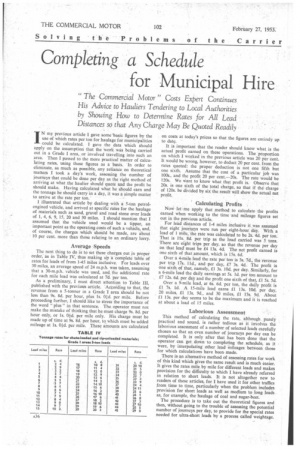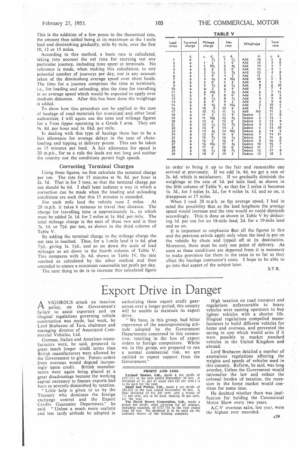Completing a Schedule for Municipal Hire
Page 54

Page 57

If you've noticed an error in this article please click here to report it so we can fix it.
"The Commercial Motor" Costs Expert Continues His Advice to Hauliers Tendering to Local Authorities by Showing How to Determine Rates for All Lead Distances so that Any Charge May Be Quoted Readily IN my previous article 1 gave some 'basic figures by the use of which rates per ton for haulage for municipalities could be calculated. I gave the data which should apply on the assumption that the work was being carried out in a Grade I area, or involved travelling into such an area. Then I passed to the more practical matter of calculating rates, using these figures as a basis. In order to eliminate, as much as possible, any reliance on theoretical matters I took a day's work, assessing the number of journeys that could be done per day as the right method of arriving at what the haulier should quote and the profit he should make. Having calculated what he should earn and the tonnage he should carry in a day, it was a simple matter to arrive at the rate per ton.
I illustrated that article by dealing with a 5-ton petrolengined vehicle, and arrived at specific rates for the haulage of materials such as sand, gravel and road stone over leads of 1, 4, 6, 9, 15, 20 and 30 miles. I should mention that I assumed that the vehicle used would be a tipper, an important point as the operating costs of such a vehicle, and, of course, the charges which should be made, are about 10 per cent. more than those relating to an ordinary lorry.
Average Speeds The next thing to do is to set these charges out in proper order, as in Table IV, thus making Lip 'a complete table of rates for leads of from 1-45 miles inclusive. For leads over 30 miles, an average speed of 24 m.p.h. was taken, assuming that a 30-m.p.h. vehicle was used, and the additional rate for each mile lead was calculated at 7d. per ton.
As a preliminary, I must direct attention to Table III, published with the previous article. 'According to that, the revenue from a 5-tonner in a Grade I area should be not less than 9s. 8d. per hour, plus Is. Old. per mile. Before proceeding further, I should like to stress the importance of the word " plus" in that sentence. The operator must not make the mistake of thinking that he must charge 9s. 8d. per hour only, or Is. Old. per mile only. His charge must be made up of time at 9s. 8d. per hour, to which must be added mileage at Is. Old. per mile. These amounts are calculated on costs at today's prices so that the figures are entirely up to date.
It is important that the reader should know what is the actual profit earned on these operations. The proportion on which I worked in the previous article was 20 per cent. It would be wrong, however, to deduct 20 per cent, from the rates quoted: the proper deduction is not one fifth but one sixth. Assume that the cost of a particular job was 100s., and the profit 20 per cent.-20s. The rate would be 120s. We Want to know what that profit is. Observe that 20s. is one sixth of the total charge, so that if the charge of 120s. be divided by six the result will show the actual net profit.
Calculating Profits
Now let .me apply that method to calculate the profits earned when working to the time and mileage ligures set out in the previous article.
For lead distances of 1-4 miles inclusive it was assumed that eight journeys were run per eight-hour day. With a lead of 1 mile, the rate was calculated to be 2s. 4d. per ton. That is Its. 8d. per trip as the load carried was 5 tons. There are eight trips per day, so that the revenue per day on that lead' must be £4 13s. 4d. The net profit earned is one sixth of that amount, which is 15s. 6d.
Over a 4-mile lead the rate per ton is 3s. 7d., the revenue per trip 17s. 11d., and per day, £7 3s. 4d. The profit is one sixth of that, namely, £1 3s. 10d. per day. Similarly, for a 6-mi1e lead the daily earnings at 5s. Id. per ton amount to £7 12s. 6t per day and the profit one sixth of that, £1 5s. 5d.
Over a 9-mile lead, at 6s. 6d. per ton, the daily profit is £1 7s. ld. A 15-mile lead earns £1 13s. 10d. per day, 20 miles, £1 13s. 9d., and 30 miles, Li 13s, 9d. About £1 13s. per day seems to be the maximum and it is reached at about a lead of 15 miles.
Laborious Assessment
This method of calculating the rate, although purely practical and sound, is rather tedious as it involves the laborious assessment of a number of selected leads carefully chosen so that an even number of journeys per day can be completed. It is only after that has been done that the operator can get down to completing the schedule, as it were, by interpolating other lead mileages between those for which calculations have been made.
There is an alternative method of assessing rates for work of this kind which gives the same result and is much easier. It gives the rates mile by mile for different leads and makes provision for the difficulty to which I have already referred in relation to short leads. It is not altogether new to readers of these articles, for I have used it for other traffics from time to time, particularly when the problem includes provision for short leads as well as medium to long leads as, for example, the haulage of coal and sugar-beet.
The procedure is to take out the theoretical figures and then, without going to the trouble of assessing the potential number of journeys per day, to provide for the special rates needed for ultra-short leads by a process called weightage. This is the addition of a few pence to the theoretical rate, the amount thus added being at its maximum at the 1-mile lead and diminishing gradually, mile by mile, over the first 10, 12 or 15 miles.
According to this method, a basic rate is calculated, taking into account the net time for carrying out any particular journey, including time spent at terminals. No reference is made, when making this calculation, to any potential number of journeys per day, nor is any account taken of the diminishing average speed over short hauls. The time for a journey comprises the time at terminals, i.e., for loading and unloading, plus the time for travelling at an average speed which would be expected to apply over medium distances. After this has been done the weightage is added.
To show how this procedure cart be applied in the case of haulage of road materials for municipal and other local authorities, I will again use the time and mileage figures for a 5-ton tipper operating in a Grade I area. They are 9s. 8d. per hour and Is 04d. per mile.
In dealing with this type of haulage there has to be a fair allowance for average delays in the case of chuteloading and tipping at delivery points. This can be taken as 15 minutes per load. A fair allowance for speed is 20 m.p.h., for as a rule the leads are not long and neither the country nor the conditions permit high speeds.
Correcting Terminal Charges
Using these figures, we first calculate the terminal charge per ton. The rate for 15 minutes at 9s. 8d. per hour is 2s. 5d. That is for 5 tons, so that the terminal charge per ton should be 6d. I shall later indicate a way in which a correction can be made when the loading and unloading conditions are such that this 15 minutes is exceeded.
For each mile lead the vehicle runs 2 miles. At 20 m.p.h. it takes 6 minutes to travel that distance. The charge for travelling time is approximately Is., to which must be added 2s. Id. for 2 miles at Is. Old. per mile. The total mileage charge is the sum of these two and is thus 3s. Id. or 70. per ton, as shown in the third column of Table V.
By adding the terminal charge to the mileage charge the net rate is reached. Thus, for a 1-mile lead it is 6d. plus 71d., giving Is. 114d., and so on down the scale of lead mileages as set down in the fourth column of Table V. This compares with 2s, 4d. shown in Table IV, the rate reached as calculated by the other method and then amended to ensure a minimum seasonable net profit per day.
The next thing to do is to increase this calculated figure in order to bring it up to the fa'r and reasonable one arrived at previously. If we add Is. 4d. we get a rate of 2s. 6d, which is satisfactory. If we gradually diminish the weightage at the rate, of id. pet mile lead, as shown in the fifth column of Table V, so that for 2 miles it becomes Is. 3d., for 3 miles is. 2d., for 4 miles Is. Id. and so on, it disappears at 17 miles.
When I took 20 m.p.h. as the average speed, I had in mind the possibility that as the lead lengthens the average speed would increase and the rate would or could diminish accordingly. This is done as shown in Table V by deducting Id. per ton for an 18-mile lead, 2d. for a 19-mile lead and so on, It is important to emphasize that all the figures in this and the previous article apply only when the load is put on the vehicle by chute and tipped off at its destination. Moreover, there must be only one point of delivery. As soon as these conditions are departed from it is necessary to make provision for them in the rates in so far as they affect the haulage contractor's costs. I hope to be able to go Into that aspect of the subject later. S.T.R.




















































































